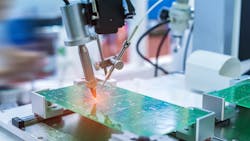PCB Manufacturing Trends You Should Know in 2021
What you’ll learn:
- What are the latest PCB manufacturing trends?
- PCB techniques used by manufacturers.
The Internet of Things is spreading everywhere, and we’ve come to realize that every device needs to be smart in the digital era. The same trajectory is happening with printed circuit boards (PCBs), pushing PCB designers to create synthesized and modified versions of their designs. These days, we’re seeing multilayer and a variety of low-volume PCBs.
PCB assembly is becoming challenging for those who don’t use the latest PCB manufacturing trends. Initially, you may require low-volume PCB assembly to test the PCB-based product before moving onto mass production.
As the PCB industry expands to meet IoT demands, it’s also experiencing rising costs. Consequently, more manufacturers are turning to the latest PCB design trends. Let’s take a look.
High-Power Boards in High Demand
Technology advances now allow manufacturers to build high-power PCBs that can manage voltage above 48 V. It’s opened the door for high-power board installation into a wider range for devices.
The reason for increasing the power of PCBs is that they can accommodate ample components. With an enhanced battery package, the PCB is able to operate longer. On top of that, PCBs are becoming thinner and more lightweight, improving their efficiency, heat absorption capability, and durability. For instance, the latest high-power PCBs can hold more thermal energy, optimizing heat dissipation.
PCB Autoplacers
Today, PCB manufacturers include autoplacers in their PCB designs. This automation process has become much more efficient and helps smooth electronic-device operation.
Automation processes for building autorouters of course are big time-savers. As a result, these autoplacer processes have helped speed time-to-market and improved operational quality.
In addition to the greater speed, manufacturers are looking to integrate CAD systems into the process. Thanks to autoplacers and flexible design software, PCB manufacturing—especially multilayer PCBs—becomes much smoother and easier.
Biodegradable PCBs
Electronic waste management issues have become a global concern. To help offset those problems, biodegradable PCBs are rising in popularity.
Disposal of PCBs—typically the largest component of electronic devices—was harmful to the environment due to the chemicals used in them, as well as their inability to degrade. The biodegradable versions eliminate those issues. In addition, some in the industry support the idea of extracting metals from E-waste, including palladium, silver, gold, gallium, and tantalum, which they can reuse through refining (and it helps reduce the pressure on mining for these elements).
Flexible PCBs
A PCB’s flexibility is crucial because it allows a single board to manage several functions. Low-volume PCB assembly requires the flexibility to place several components on a single board.
It should come as no surprise that flexible PCBs are already becoming more favorable than their rigid PCB counterparts due to the ability to handle mode stress and bending properties. It’s not certain whether it will translate into sales growth, but flexible PCBs are nonetheless popular among customers.
Flexible PCBs can mold into any shape or size. One of the most common flexible technologies is through-hole PCB assembly that allows for smooth attachment of every component. It’s flexible nature has led to several key medical instrument advances.
Conclusion
The journey of a PCB goes from design to prototype, then low-volume PCB assembly, and finally mass production. Technology advances continue to pave a smoother path on the manufacturing front, so expect many more PCB technology changes to emerge in the upcoming years. And as designs move to more flexible varieties, they will be able to fit into virtually every type of electronics system.
About the Author
Ken Ghadia
Senior Sales Engineer, TechnoTronix
Ken works as Sales Engineer at Technotronix. He brings 15 years of experience in PCB sales and technical client services.
